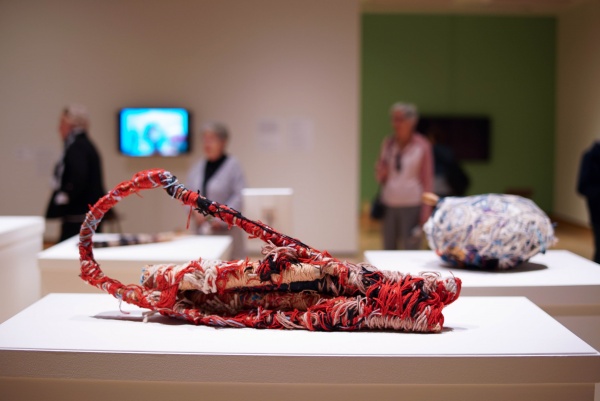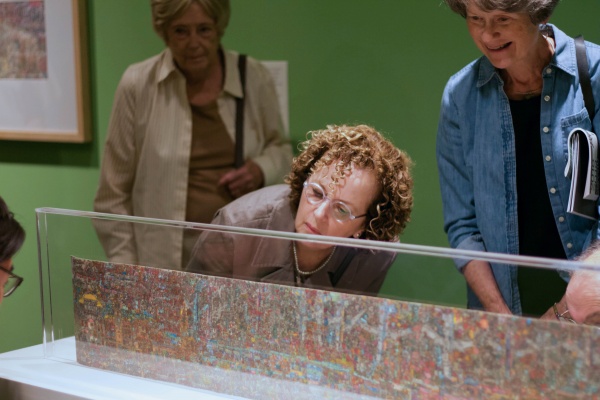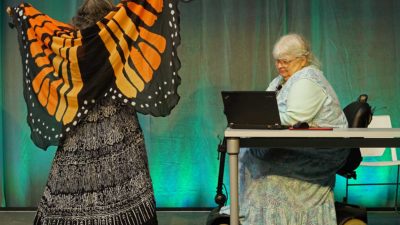Jill Vyn and Chris Smit, Co-Directors of DisArt, a disability arts organisation based in Michigan, USA introduce their exhibition Process and Presence: Contemporary Disability Sculpture discussing the various accessibility features they implemented, including a virtual tour and online gallery with accompanying audio descriptions and soundscapes.
The virtual exhibition tour is available at the bottom of the page.

As an organization, DisArt believes that expressions of a Disabled cultural identity can transform society from awareness to understanding to belonging, creating a community that enjoys the full and equitable participation of all Disabled people.
On the surface, this mission may appear lofty or even idealistic. And yet, after four years of programming large and small public events centered around the best, international contemporary art available from Disabled artists, we are now, more than ever before, convinced of the fact that the creative act of art-making, dance, fashion, and performance offer unique opportunities to disrupt the worn-out, often discriminatory, stories we tell ourselves about people who live with physical and mental differences.
Indeed, stereotypes and thinly drawn renditions of disability pale against the authentic expression of the Disabled artist. This has certainly been the case with our most recent exhibition Process and Presence: Contemporary Disability Sculpture which has been on display since September of 2018 in the galleries of Frederik Meijer Gardens & Sculpture Park (Meijer Gardens) in Grand Rapids, Michigan USA. The exhibition is part of DisArt’s Process and Presence season of events which included a fashion show, lectures, artist workshops, and podcast episodes spread over four months.
Process and Presence: Contemporary Disability Sculpture was co-curated by DisArt and Meijer Gardens. This exhibition presents three-dimensional works from the United States, Japan, Taiwan, Australia, and the UK, all of which speak to the fundamental experience of change and adaptation deeply embedded within Disability culture. And although each object in this collection maintains the accent of its country of origin, visitors are encouraged to note the aesthetic and communicative commonalities between them as well. Indeed, although the exhibition stops short of advocating for a universalized understanding of disability, witnessing the stylistic connections between these sculptures, films, and performances hints at the potential gains made possible by identifying what might be best understood as a shared Disabled imagination.
Like many organizations that produce Disability Art events, DisArt understands that in order for any exhibition to create a palpable impact on visitors the rigour of selecting works must be matched by the energy spent on making the experience accessible and welcome to the widest audience possible. This type of work includes paying attention to the height of sculpture pedestals, lighting decisions, object hanging, wall text size and overall layout of the objects within the gallery.

For example, the work in Process and Presence demands a good deal of space, both physically and theoretically. The concepts and expressions embedded in works by Judith Scott, for instance, are not quickly digested, but rather demand commitments within space and time which gallery visitors are perhaps not accustomed to. Thus, the placement of these objects, and the spatial relationship they have to themselves and other objects in the show, was done under careful consideration.
DisArt has also discovered that our visitors prefer to have options when it comes to accessing the programming content virtually as well. It is because of this that we remain committed to experimenting with different creative access solutions on our website.
DisArt has expanded its virtual access by using technology associated with virtual tours and 3D mapping. We began to be curious about the potential advantages of expanding both space and duration through the use of online technologies from other arenas of social life, like real-estate imaging. With the help of Sherry Rennick and her company Perspective 3-D, DisArt started employing online technology as a way to invite the participation of remote audiences who do not plan to visit the physical space of the gallery.
The benefits of offering virtual gallery experiences go beyond this primary use of allowing offsite visitors to engage the work. For example, virtual tours are a good way for DisArt to help folks manage expectations for on-site visits as well. People who live with spatial-based disabilities, or those living with neurodiversity, can find the physical experience of being within a brightly lit gallery quite daunting. However, by exploring the space online before they arrive, the hope is that they have been in power to understand and predict the manner in which they will navigate the geographic contextual space of the gallery.
The virtual tour is just one way that visitors can experience the exhibition. Another is through our online gallery that includes audio soundscapes for each of the works of art included in the exhibition. These soundscapes combine verbal descriptions of the objects with musical ones. The audio soundscapes is an experimental project created by DisArt volunteer and musician Lizzie Dunn and executed by Lizzie and her musician partner Tyler Zahnke. DisArt volunteer Zoe Pentaleri provided the audio descriptions.
In the end, we hope that this type of virtual offering illustrates a willingness to be creative when it comes to imagining how exhibitions could be interacted with by a wide variety of visitors. Like the objects in the exhibition themselves, the access measures offered by DisArt and Meijer Gardens for Process and Presence embody the same spirit of invention, creativity, and reaction to change that is at the core of a Disabled culture.


